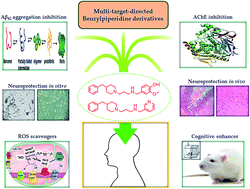Novel insights into multitargeted potential of N′-(4-benzylpiperidin-1-yl)alkylamine derivatives in the management of Alzheimer's disease associated pathogenesis†
Abstract
In response to the molecular complexity of AD, the strategy of multi-target directed ligand (MTDL) holds great potential in modulating different targets involved in the neurodegenerative cascade of AD. In this context, there is a need for the use of privileged scaffolds for discovering potential multifunctional agents for AD treatment. Our group have previously reported a novel series of benzyl piperazine/piperidine based multifunctional agents endowed with in vitro profile appropriate for identifying novel lead candidates with disease-modifying potential. Herein, we have further made an attempt to decipher some of the key mechanisms behind the multitargeted potential of most active inhibitors (5h and 5k) and their characterization for anti-Alzheimer effects. In the present study, investigation of compounds 5h and 5k through CD experiments confirmed their ability in preventing β-sheet aggregation and fibril formation. Morphological visualization in TEM suggested that test inhibitors may interfere with rate of peptide nucleation, leading to short fibrillar aggregates. ThT based fluorimetric assay further demonstrated that 5h and 5k inhibited AChE-mediated Aβ fibrillogenesis via their interaction with the AChE peripheral anionic site. Molecular docking and simulations studies indicated that these compounds could potentially bind to Aβ by inhibiting the toxic conformation of Aβ1–42 and stabilizing the α-helical content. Furthermore, compounds exerted neuroprotective action on SH-SY5Y cells towards Aβ and H2O2-mediated cell death and oxidative injury by inhibiting ROS generation. Moreover, administration of 5h and 5k (5 mg kg−1), significantly reversed scopolamine-induced neurobehavioral, biochemical, neurochemical and histopathological changes in a manner comparable to standard drug donepezil. Together, the present findings provide novel insights into disease-modifying potential of benzylpiperidine derivatives towards the management of AD.


 Please wait while we load your content...
Please wait while we load your content...